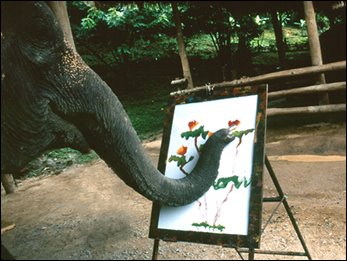The rule of thirds
The picture is not focused merely on the yak - however vibrant it's saddle may be - but on an artistic amalgam of yak and environment (presumably some isolated Himalayan vista), the latter of which is certainly entrancing enough to equal or exceed the inherent splendor held by this yak and its distinctive trappings. There are a few constructive criticisms that come to mind when I contemplate this image, such as the position of the photographer. If this unnamed individual had moved a little closer and managed to fit the yak's face into the frame, while simultaneously capturing the spellbinding background and lively getup, the picture would be stupendously more aesthetically pleasing. I scavenged this remarkable photograph from the web site Tibetan Train Travel, which can be viewed using this simple link.
I was struck by this highly expressive photograph of a hippo while I perused the many pages of Wildlife-photo.org. Based on my impromptu understanding of photography, I would say that this is a spectacular example of a picture. Clearly visible is the photographer's talent for the use of the rule of thirds, depth of field, camera position, color, and doubtless many other obscure bits of photographical protocol which, taken together, dramatically enhance the appeal of the image. With but a passing glance, one can discern how the position of the gaping maw is roughly aligned with a part of the rule of thirds (as shown above), and that the eye is also along a line, but centered, indicating that the focal point of the image is intended to be the yawning abyss of pink flesh, fearsome tusks, and ghastly nubs of blackened molar that is the mouth of a grown hippopotamus, or Hippopotamus Amphibius (from Greek). Also apparent is the use of depth of field, where the opposite bank and farthest hippo head fade into indistinction, imparting a sense of realism to the picture, making it seem almost like a window.

No comments:
Post a Comment